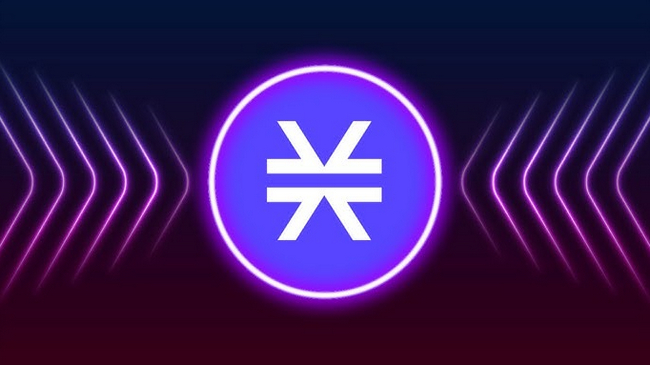-
 Bitcoin
Bitcoin $87,523.6964
3.26% -
 Ethereum
Ethereum $1,646.4082
3.22% -
 Tether USDt
Tether USDt $1.0000
0.00% -
 XRP
XRP $2.1288
2.92% -
 BNB
BNB $605.7126
1.96% -
 Solana
Solana $140.2824
0.62% -
 USDC
USDC $0.9999
0.00% -
 Dogecoin
Dogecoin $0.1622
3.35% -
 TRON
TRON $0.2455
1.60% -
 Cardano
Cardano $0.6464
3.45% -
 Chainlink
Chainlink $13.6669
5.23% -
 UNUS SED LEO
UNUS SED LEO $9.4428
1.13% -
 Avalanche
Avalanche $20.8903
6.50% -
 Stellar
Stellar $0.2588
5.72% -
 Toncoin
Toncoin $3.0491
2.18% -
 Shiba Inu
Shiba Inu $0.0...01272
2.84% -
 Hedera
Hedera $0.1735
5.65% -
 Sui
Sui $2.2481
5.36% -
 Bitcoin Cash
Bitcoin Cash $341.9682
2.17% -
 Polkadot
Polkadot $3.9685
2.57% -
 Hyperliquid
Hyperliquid $18.3224
3.32% -
 Litecoin
Litecoin $80.5596
5.16% -
 Dai
Dai $1.0000
0.00% -
 Bitget Token
Bitget Token $4.4661
-0.61% -
 Ethena USDe
Ethena USDe $0.9992
0.00% -
 Pi
Pi $0.6374
0.64% -
 Monero
Monero $214.9777
-0.72% -
 Uniswap
Uniswap $5.4812
4.01% -
 Pepe
Pepe $0.0...07866
5.37% -
 Aptos
Aptos $5.2374
7.10%
How to obtain STX coin? A complete picture and text tutorial on how to purchase and obtain STX coin
To acquire STX, create an account on a crypto exchange that supports its trading, fund your account, find the STX trading pair, place a buy order, and store your STX in a compatible wallet.
Oct 05, 2024 at 05:53 pm

How to Obtain STX Coin: A Comprehensive Guide
Step 1: Create an Account on a Crypto Exchange
- Select a reputable crypto exchange such as Binance, Coinbase, or Gemini that supports STX trading.
- Register for an account, providing personal information and verification documents.
Step 2: Fund Your Account
- Deposit funds into your account using bank transfer, wire transfer, or credit/debit card.
- Supported currencies vary depending on the exchange.
Step 3: Find the STX Trading Pair
- In the crypto exchange's trading terminal, search for the trading pair corresponding to your desired purchase: STX/USDT, STX/BTC, etc.
Step 4: Place a Buy Order
- Determine the amount of STX you wish to purchase.
- Choose an order type (market order or limit order) and specify the price.
- Confirm and execute the trade.
Step 5: Store Your STX
- Once the trade is complete, store your STX in a hardware wallet or software wallet compatible with Stacks (STX).
Additional Methods to Obtain STX:
1. Staking:
- Stake your STX in the Stacks network through a reliable staking pool.
- You will receive rewards in the form of additional STX for participating in network operations.
2. Mining:
- Mine STX using specialized mining hardware.
- This method requires significant technical expertise and computing power.
3. Airdrop Campaigns:
- Occasionally, Stack Foundation distributes STX through airdrop campaigns to promote usage and adoption.
- Follow Stacks Foundation on social media and check their website for announcements.
4. Stacking:
- Participate in the Stacking program by locking up BTC in a PoX (Proof-of-Transfer) contract on the Stacks network.
- You will earn STX as a reward for participating.
Disclaimer:info@kdj.com
The information provided is not trading advice. kdj.com does not assume any responsibility for any investments made based on the information provided in this article. Cryptocurrencies are highly volatile and it is highly recommended that you invest with caution after thorough research!
If you believe that the content used on this website infringes your copyright, please contact us immediately (info@kdj.com) and we will delete it promptly.
- The crypto market stayed quiet over the weekend, with Bitcoin trading in a narrow range between $83,000 and $87,000.
- 2025-04-21 15:50:12
- Ambient Leverages Solana's High Speed and Efficiency, Introduces Proof of Logits (PoL) Mechanism
- 2025-04-21 15:50:12
- Can Web3 Finally Deliver What Web2 Failed to—ownership, speed, and privacy in one shot?
- 2025-04-21 15:45:12
- Bitcoin (BTC) Price Breaks Out Above $87,400, Reigniting Bullish Sentiment
- 2025-04-21 15:45:12
- Digital gold, Bitcoin and gold prices climb after Trump declares 'HE WHO HAS THE GOLD MAKES THE RULES'
- 2025-04-21 15:40:12
- The second quarter of 2025 began with difficulties for altcoins
- 2025-04-21 15:40:12
Related knowledge

What is Ethereum’s Slashing mechanism and how to punish malicious behavior?
Feb 20,2025 at 03:08am
Key PointsOverview of slashingDifferent types of slashing in EthereumIncentives and consequences of slashingIdentifying and reporting slashed validatorsOngoing discussions and potential improvementsEthereum's Slashing Mechanism: Punishing Malicious BehaviorEthereum's slashing mechanism is an essential tool for ensuring network security and punishing mal...

What is the verifier node of Ethereum and how to become a verifier?
Feb 19,2025 at 06:00pm
The Verifier Node of Ethereum: A Comprehensive GuideKey Points:What is a Verifier Node?How to Become a Verifier NodeResponsibilities and Rewards of a Verifier NodeMinimum Requirements for Becoming a Verifier NodePotential Difficulties in Running a Verifier Node1. What is a Verifier Node?A Verifier Node is an independent entity on the Ethereum network th...

What is Ethereum’s staking, and how to participate and earn money?
Feb 19,2025 at 04:37pm
Key Points:Understanding Ethereum's Staking MechanismSteps to Participate in StakingBenefits and Rewards of StakingSecurity and Risk ConsiderationsTechnical Requirements and Hardware OptionsPotential Challenges and Troubleshooting TipsFAQs on Ethereum StakingWhat is Ethereum's Staking?Proof-of-Stake (PoS) is a consensus mechanism used in blockchain netw...

What is Ethereum’s DAO (Decentralized Autonomous Organization) and how does it work?
Feb 20,2025 at 03:12am
Key PointsDefinition and Structure of a DAOGovernance and Decision-Making in DAOsBenefits and Use Cases of DAOsChallenges and Limitations of DAOsWhat is Ethereum's DAO (Decentralized Autonomous Organization) and How Does It Work?Definition and Structure of a DAOA Decentralized Autonomous Organization (DAO) is an innovative governance and management fram...

What is Ethereum's multi-signature wallet and how to improve security?
Feb 20,2025 at 02:18pm
Key Points:Understanding the Concept of a Multi-Signature WalletBenefits and Drawbacks of Multisig WalletsRequirements for Setting Up a Multisig WalletStep-by-Step Guide to Generating a Multisig WalletImplementing Strategies for Enhanced Security1. Understanding the Concept of a Multi-Signature WalletA multi-signature (multisig) wallet in the Ethereum e...

What is Ethereum's oracle and how to provide data for smart contracts?
Feb 21,2025 at 01:30am
Key Points:Understanding the concept of oracles in EthereumExploring different types of oraclesDetailed guide on how to provide data for smart contractsAddressing potential challenges and considerationsWhat is Ethereum's Oracle?Oracles are crucial components in the Ethereum ecosystem, enabling smart contracts to access real-world data and off-chain even...

What is Ethereum’s Slashing mechanism and how to punish malicious behavior?
Feb 20,2025 at 03:08am
Key PointsOverview of slashingDifferent types of slashing in EthereumIncentives and consequences of slashingIdentifying and reporting slashed validatorsOngoing discussions and potential improvementsEthereum's Slashing Mechanism: Punishing Malicious BehaviorEthereum's slashing mechanism is an essential tool for ensuring network security and punishing mal...

What is the verifier node of Ethereum and how to become a verifier?
Feb 19,2025 at 06:00pm
The Verifier Node of Ethereum: A Comprehensive GuideKey Points:What is a Verifier Node?How to Become a Verifier NodeResponsibilities and Rewards of a Verifier NodeMinimum Requirements for Becoming a Verifier NodePotential Difficulties in Running a Verifier Node1. What is a Verifier Node?A Verifier Node is an independent entity on the Ethereum network th...

What is Ethereum’s staking, and how to participate and earn money?
Feb 19,2025 at 04:37pm
Key Points:Understanding Ethereum's Staking MechanismSteps to Participate in StakingBenefits and Rewards of StakingSecurity and Risk ConsiderationsTechnical Requirements and Hardware OptionsPotential Challenges and Troubleshooting TipsFAQs on Ethereum StakingWhat is Ethereum's Staking?Proof-of-Stake (PoS) is a consensus mechanism used in blockchain netw...

What is Ethereum’s DAO (Decentralized Autonomous Organization) and how does it work?
Feb 20,2025 at 03:12am
Key PointsDefinition and Structure of a DAOGovernance and Decision-Making in DAOsBenefits and Use Cases of DAOsChallenges and Limitations of DAOsWhat is Ethereum's DAO (Decentralized Autonomous Organization) and How Does It Work?Definition and Structure of a DAOA Decentralized Autonomous Organization (DAO) is an innovative governance and management fram...

What is Ethereum's multi-signature wallet and how to improve security?
Feb 20,2025 at 02:18pm
Key Points:Understanding the Concept of a Multi-Signature WalletBenefits and Drawbacks of Multisig WalletsRequirements for Setting Up a Multisig WalletStep-by-Step Guide to Generating a Multisig WalletImplementing Strategies for Enhanced Security1. Understanding the Concept of a Multi-Signature WalletA multi-signature (multisig) wallet in the Ethereum e...

What is Ethereum's oracle and how to provide data for smart contracts?
Feb 21,2025 at 01:30am
Key Points:Understanding the concept of oracles in EthereumExploring different types of oraclesDetailed guide on how to provide data for smart contractsAddressing potential challenges and considerationsWhat is Ethereum's Oracle?Oracles are crucial components in the Ethereum ecosystem, enabling smart contracts to access real-world data and off-chain even...
See all articles






















































































